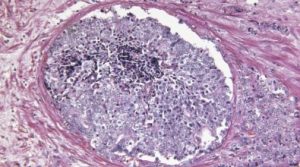About Cancer
According to the American Cancer Society, cancer is a group of diseases characterized by uncontrolled growth and spread of abnormal cells. If the spread is not controlled, it can result in death. Its characteristics are:
Abnormality: Cells are the structural units of all living things. Each of us has trillions of cells, as does a growing tree. Cells make it possible for us to carry out all kinds of functions of life: the beating of the heart, breathing, digesting food, thinking, walking, and so on. However, all of these functions can only be carried out by normal healthy cells. Some cells stop functioning or behaving as they should, serving no useful purpose in the body at all, and become cancerous cells.

 Uncontrollability: The most fundamental characteristic of cells is their ability to reproduce themselves. They do this simply by dividing. One cell becomes two, the two become four, and so on. The division of normal and healthy cells occurs in a regulated and systematic fashion. In most parts of the body, the cells continually divide and form new cells to supply the material for growth or to replace worn-out or injured cells. For example, when you cut your finger, certain cells divide rapidly until the tissue is healed and the skin is repaired. They will then go back to their normal rate of division. In contrast, cancer cells divide in an uncontrolled manner and/or do not die in the usual, controlled way cells typically do. The result is that they pile up into a non-structured mass, or tumor. Some disorders are more systemic in nature and do not form a lump, mass or tumor.
Uncontrollability: The most fundamental characteristic of cells is their ability to reproduce themselves. They do this simply by dividing. One cell becomes two, the two become four, and so on. The division of normal and healthy cells occurs in a regulated and systematic fashion. In most parts of the body, the cells continually divide and form new cells to supply the material for growth or to replace worn-out or injured cells. For example, when you cut your finger, certain cells divide rapidly until the tissue is healed and the skin is repaired. They will then go back to their normal rate of division. In contrast, cancer cells divide in an uncontrolled manner and/or do not die in the usual, controlled way cells typically do. The result is that they pile up into a non-structured mass, or tumor. Some disorders are more systemic in nature and do not form a lump, mass or tumor.
Invasiveness: Sometimes tumors do not stay harmlessly in one place. They destroy the part of the body in which they originate and then spread to other parts where they start new growth and cause more destruction. This characteristic distinguishes cancer from benign growths, which remain in the part of the body in which they start. Although benign tumors may grow quite large and press on neighboring structures, they do not spread to other parts of the body.
Frequently, they are completely enclosed in a protective capsule of tissue and they typically do not pose danger to human life like malignant tumors (cancer) do. A metastatic tumor is one which has had cells break away and travel to other parts of the body and grow in places such as the liver, lungs, bones, or brain. For example, metastases (cancerous cells) from the breast can travel to the liver, bones or brain and create new tumors. They are not brain, bone or lung cancer, but, rather, breast cancer growing in the brain, bone or lung.
A group of diseases: Although cancer is often referred to as a single condition, it actually consists of hundreds of different diseases. These diseases are characterized by uncontrolled growth and spread of abnormal cells. Cancer can arise in many sites and behave differently depending on its organ of origin. Breast cancer–of which there are at least 10 different main types–has different characteristics than lung cancer. It is important to understand that cancer originating in one body organ takes its characteristics with it even if it spreads to another part of the body. For example, metastatic breast cancer in the lungs continues to behave like breast cancer and, when viewed under a microscope, it continues to look like a cancer that originated in the breast.
- https://www.cancercare.org/
- https://www.nccn.org/professionals/physician_gls/default.aspx
- https://www.cancer.org/
- https://www.cancer.gov/
- https://health.utah.gov/
- https://www.lls.org/mtn
- https://www.mycoloncancercoach.org/
- https://www.mybreastcancercoach.org/
- https://www.myprostatecancercoach.org/
- https://www.communitycancertrials.com/
- https://www.northernutahcancerfoundation.org/
- https://www.cdc.gov/cancer/

